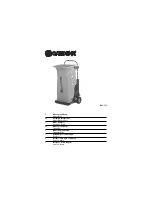
16
B-line stall
The B-stall is a stall descent technique where the canopy’s aerofoils are deformed by
pulling the row of B lines down. The paraglider sinks vertically with a sink rate of approx. 7-
8 m/s.
To induce a B-line stall symmetrically pull down slowly on both B-risers, until the canopy
folds (parallel to its long axis). The airflow over the top surface is almost fully detached and
the canopy enters a vertical descent flight mode without forward movement. Further pulling
of the B-risers reduces the surface area more and increases the sink rate. Be careful,
pulling too far or too rapidly may cause a frontal horseshoe to form. To exit from this flight
mode release the B-risers at first rapidly but then gently (1 sec). The canopy surges
forward re-attaching the airflow over the top surface and resumes normal flight. When the
B-risers are released, the brakes should not be activated. This will give the canopy the
chance to gain speed and resume normal flight. On exit from a B-line stall on no account
just release the B-risers, as this can cause overloading. If canopy does not recover apply
both brakes gently to recover or pull the A-risers, until the canopy regains forward speed.
Attention! The canopy surges forward after B-risers have been released until the airflow
reattached. To prolong lifetime of your glider we don't recommend B-Stall as a usual
descent technique.
Attention! All rapid descent techniques should first be practised in calm air and with
sufficient height so the pilot can use them in emergency situations! By far the best
technique is to fly correctly and safely, so you never have to descend rapidly!
Approach and Landing
To avoid excessively demanding situations on the approach to landing, it is important to
initiate the process at an adequate altitude. This leaves you enough time to observe and
appropriately deal with wind direction and any other gliders in your vicinity.
The Aravis is easy to land. The final leg of the landing approach must be into the wind.
Adopt an upright position in your harness by sliding your legs forward, ready to make
contact with the ground. During this final glide the paraglider should be decelerated slowly
and at approximately one meter above the ground, according to conditions, the pilot should
flare the canopy. The glider may climb again, gaining height, if too much brake is used too
early. Higher wing loading results in a higher ground speed. Make sure you always land
into the wind.
In nil wind situations, be prepared to run fast. In stronger winds, use only the minimum
amount of flare necessary to sufficiently minimize your vertical and horizontal speed. If you
flare too hard in strong winds, the glider will climb rapidly upwards and backwards, and you
may get injured. In strong winds, turn to face your wing as soon as your feet touch the
ground. Immediately stall the glider as rapidly as possible with the brakes or rear risers.
Be prepared to run towards your wing.
Attention! Do not allow the canopy to fall onto the leading edge with energy. This can
destroy the material and affects the life of the ribs at the leading edge!
Ground handling on rough surfaces will accelerate the ageing process of your wing.
Содержание ARAVIS 17
Страница 1: ...1 ...
Страница 31: ...31 LINE PLAN ARAVIS ...
Страница 34: ...34 CHECKS Name Company Date Signature Stamp ...
Страница 36: ...36 ...
















































